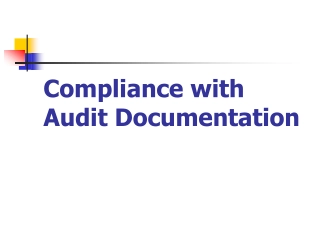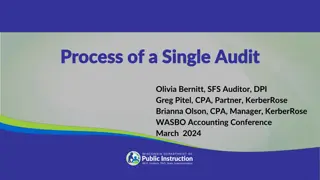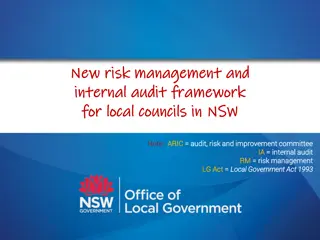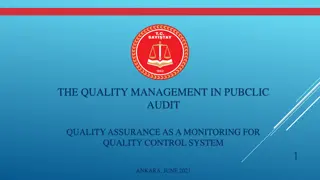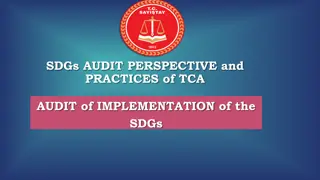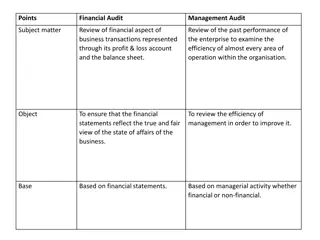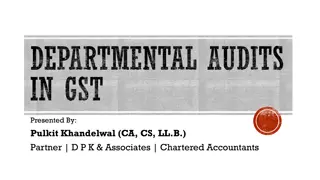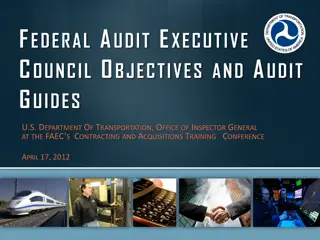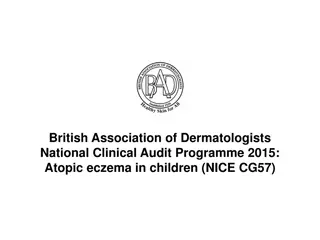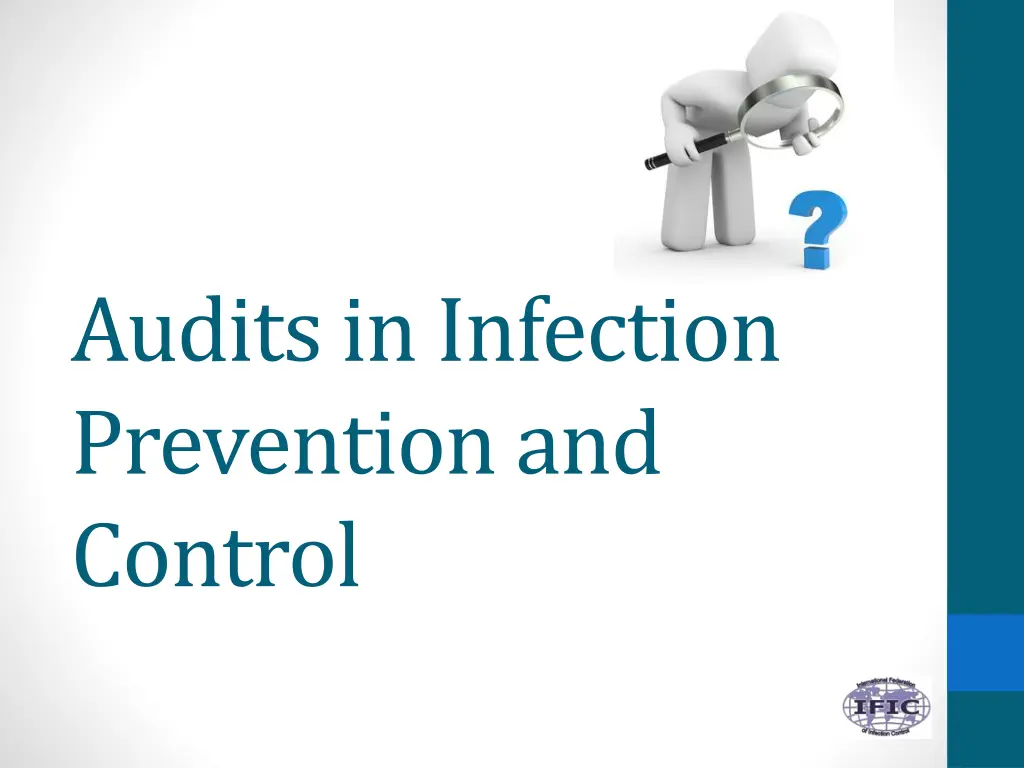
Infection Prevention and Control Audits Overview
Explore the importance of audits in infection prevention and control (IP&C) practices, learn about audit tools and methods, understand the key principles, objectives, and time involved in audits. Discover the significance of reporting noncompliance, identifying areas for improvement, monitoring risk management, and utilizing the PDSA cycle in healthcare settings.
Download Presentation

Please find below an Image/Link to download the presentation.
The content on the website is provided AS IS for your information and personal use only. It may not be sold, licensed, or shared on other websites without obtaining consent from the author. If you encounter any issues during the download, it is possible that the publisher has removed the file from their server.
You are allowed to download the files provided on this website for personal or commercial use, subject to the condition that they are used lawfully. All files are the property of their respective owners.
The content on the website is provided AS IS for your information and personal use only. It may not be sold, licensed, or shared on other websites without obtaining consent from the author.
E N D
Presentation Transcript
Audits in Infection Prevention and Control
Learning objectives December 1, 2013 1. Explain the relevance of audit in IP&C practice 2. Identify audit tools and methods 3. Describe the main principles of audits 2
Time involved December 1, 2013 40 minutes 3
Key points December 1, 2013 Audit means checking practice against a standard Improves by providing information about practices Use for risk assessment, strategic planning, and root cause analysis Essential to have an audit team Results need to be known by decision makers 4
Introduction December 1, 2013 Healthcare-associated infections (HAI) are due to multiple factors Prevention depends on surveillance and infection prevention and control (IP&C) practices Practices are outlined in guidelines, policies, and procedures 5
Audit objectives December 1, 2013 Reporting of noncompliance or issues of concern Identifying where improvement is needed Monitoring and evaluating the effectiveness of the organisation s risk management process 6
Risk Management December 1, 2013 Set objectives Identify, analyse and respond to risks that could impact the organisation Internal auditors can offer advice and help risks 7
The PDSAcycle December 1, 2013 8
The PDSAcycle December 1, 2013 9
Audit tools Templates to evaluate implementation of the standard Can focus on Procedures hand hygiene, isolation, cleaning, disinfection or sterilisation Practices personal protective equipment, insertion and care of intravascular, respiratory and urinary devices, hair removal, prophylactic antibiotic December 1, 2013 10
Audit Tools December 1, 2013 Audit tools must match the recommended practices and resources of the institution The audit can be performed by the IP&C team or other designated staff 11
Audit Method December 1, 2013 Select areas Focus on a few important ones Report should include Description of the physical layout Observation of practices Action taken/Practice changed Collection of local audit data Analysed audit data 12
Audit plan December 1, 2013 13
Annual audit plan December 1, 2013 14
Preparation of Audit Team December 1, 2013 All staff must be included Need to understand its purpose is to improve practice Not punitive or to identify weaknesses Pre-audit meetings essential Consistence and anonymity Identify leaders in the area Knowledge assessment 15
Toolkits to Complete Audits December 1, 2013 Available from Community and Hospital Infection Control Association-Canada and World Health Organization Hand hygiene Standard precautions/routine practices Use of isolation/precautions Use of personal protective equipment Monitoring of sterilisation equipment And many others .. 16
Routine Reports December 1, 2013 Weekly reports Rapid feedback on incidental issues Monthly reports Audit results, education, training, and consultations Quarterly reports Formal reports including recommendations and management Annual reports A summary of audits carried and the resulting improvement 17
Behavioural Change Behavioural theories and interventions insufficient Interventions must account for different levels Interdependence of factors, environmental constraints, and institutional climate taken into account Factors necessary for change 1. Dissatisfaction with the current situation 2. Perception of alternatives 3. Recognition, of the ability and potential to change December 1, 2013 18
Basic principles: Bundles Multi-model structured way of improving processes and outcomes Collection of processes needed to effectively and safely care for patients Interventions bundled together and when combined, improve outcomes Consists of small (3-5) set of procedures, determined by robust evidence Successfully completing each step is a straightforward process and can be audited December 1, 2013 19
Bundle pack December 1, 2013 A statement of commitment A cause-effect chart Standard operating procedures Data collection sheet Explanation for staff 20
Cause and effect diagram December 1, 2013 21
Guidelines December 1, 2013 Written guidelines for each procedure Updated, acceptable, practical An audit checks if guidelines are being followed 22
Summary December 1, 2013 Data derived from audits used to inform the IP&C program The intent of audits is to promote good practice, improve patient care, and ensure safety A key person must be identified in each area to help facilitate implementation of any recommendations Auditing is relatively simple, but time-consuming Important to plan and develop an audit calendar 23
References Millward S, Barnett J, Tomlinson D. A clinical infection control audit programme. J Hosp Infect 1993; 24: 219- 232. Bryce EA, Scharf SL and Walker MM: Infection control practitioner audit form for patient/resident service units. Canadian J Infect Control 2002; 17:23-26. Yokoe DS, et al. A compendium of strategies to prevent healthcare associated infections in acute care hospitals, Infect Control Hospital Epidemiol 2008; 29 (Suppl 1): 12- 21. December 1, 2013 24
Quiz 1. Audits have demonstrated improvement in processes and outcomes. T/F An audit tool helps evaluate a) Practice against a standard b) Health care behaviour c) Surveillance d) Epidemiological investigation Regarding audits, it is incorrect that: a) The intent of audits is to promote good practice, improve patient care, and ensure safety. b) Audit means checking practice against a standard c) It is punitive d) There needs to be a plan December 1, 2013 2. 3. 25
International Federation of Infection Control IFIC s mission is to facilitate international networking in order to improve the prevention and control of healthcare associated infections worldwide. It is an umbrella organisation of societies and associations of healthcare professionals in infection control and related fields across the globe . The goal of IFIC is to minimise the risk of infection within healthcare settings through development of a network of infection control organisations for communication, consensus building, education and sharing expertise. For more information go to http://theific.org/ December 1, 2013 26

